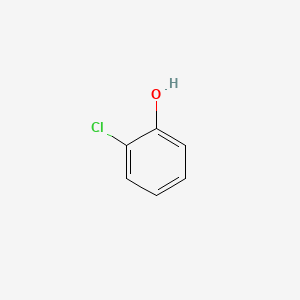



1. 2-monochlorophenol
2. O-chlorophenol
3. O-monochlorophenol
4. Ortho-chlorophenol
5. Ortho-monochlorophenol
1. O-chlorophenol
2. 95-57-8
3. Phenol, 2-chloro-
4. 2-hydroxychlorobenzene
5. O-chlorphenol
6. Chlorophenol
7. 2-chloro-1-hydroxybenzene
8. O-chlorophenic Acid
9. Phenol, O-chloro-
10. 2-chloro-phenol
11. Rcra Waste Number U048
12. Nsc 2870
13. Mfcd00002159
14. K9kav4k6bn
15. 1-chloro-2-hydroxybenzene
16. Chebi:47083
17. Nsc-2870
18. Septi-kleen
19. Dsstox_cid_1544
20. 2-chlorophenol, >=99%
21. Dsstox_rid_76202
22. Dsstox_gsid_21544
23. Pine-o Disinfectant
24. Caswell No. 203
25. O-chlorphenol [german]
26. Ortho-chlorophenol
27. Cas-95-57-8
28. 2ch
29. Ccris 640
30. Hsdb 1415
31. Einecs 202-433-2
32. Unii-k9kav4k6bn
33. Rcra Waste No. U048
34. Epa Pesticide Chemical Code 062204
35. Orthochlorophenol
36. Ai3-09060
37. 2-chloro Phenol
38. 1wbo
39. O-chlorophenol, Solid
40. O-chlorophenol, Liquid
41. Chlorophenol (related)
42. Phenol,2-chloro
43. 2-chlorophenol, 98%
44. Wln: Qr Bg
45. 2-chlorophenol (2-cp)
46. Ec 202-433-2
47. O-chlorophenol [mi]
48. Schembl12279
49. Mls002454425
50. Bidd:er0681
51. 2-chlorophenol [hsdb]
52. Chembl108877
53. Dtxsid5021544
54. Bdbm36301
55. Nsc2870
56. Hms2267f05
57. Zinc402767
58. Amy40778
59. Cs-d1478
60. Tox21_201410
61. Tox21_300340
62. Stl281867
63. Akos000118966
64. Db03110
65. Ncgc00091286-01
66. Ncgc00091286-02
67. Ncgc00091286-03
68. Ncgc00254422-01
69. Ncgc00258961-01
70. 2-chlorophenol 10 Microg/ml In Methanol
71. 25167-80-0
72. Ps-11957
73. Smr000112048
74. 2-chlorophenol 100 Microg/ml In Methanol
75. P-phenylenediamine-o-chlorophenol Copolymer
76. Db-057591
77. 2-chlorophenol 1000 Microg/ml In Methanol
78. Ft-0611987
79. 2-chlorophenol 100 Microg/ml In Isopropanol
80. 2-chlorophenol, Saj First Grade, >=99.0%
81. 2-chlorophenol, Pestanal(r), Analytical Standard
82. Q176486
83. J-509162
84. F0001-2274
85. O-chlorophenol, Solid [un2020] [keep Away From Food]
86. 2-chlorophenol, Certified Reference Material, Tracecert(r)
87. O-chlorophenol, Liquid [un2021] [keep Away From Food]
| Molecular Weight | 128.55 g/mol |
|---|---|
| Molecular Formula | C6H5ClO |
| XLogP3 | 2.1 |
| Hydrogen Bond Donor Count | 1 |
| Hydrogen Bond Acceptor Count | 1 |
| Rotatable Bond Count | 0 |
| Exact Mass | 128.0028925 g/mol |
| Monoisotopic Mass | 128.0028925 g/mol |
| Topological Polar Surface Area | 20.2 Ų |
| Heavy Atom Count | 8 |
| Formal Charge | 0 |
| Complexity | 74.9 |
| Isotope Atom Count | 0 |
| Defined Atom Stereocenter Count | 0 |
| Undefined Atom Stereocenter Count | 0 |
| Defined Bond Stereocenter Count | 0 |
| Undefined Bond Stereocenter Count | 0 |
| Covalently Bonded Unit Count | 1 |
MEDICATION (VET): ANTISEPTIC
Rossoff, I.S. Handbook of Veterinary Drugs. New York: Springer Publishing Company, 1974., p. 106
A number of rabbit studies have shown that metabolism of the monochlorophenols is principally via conjugation. In /one/ study, groups of 6 rabbits were treated by gavage with 171.3 mg/kg of 2-CP or 4-CP emulsified in water as a single dose. For both isomers, the 24-hour urine analysis indicated that between 78.1 and 88.3% of the administered dose was excreted as the glucuronide, and between 12.8 and 20.6% of the administered dose was excreted as the ethereal sulfate. A total of 101.7 and 101.1% of the administered 2-CP or 4-CP doses, respectively, was accounted for as urinary glucuronide and sulfate conjugates.
U.S. Dept Health & Human Services/Agency for Toxic Substances & Disease Registry; Toxicological Profile for Chlorophenols PB/99/166639 p.80 (July 1999). Available from, as of October 28, 2008: https://www.atsdr.cdc.gov/toxpro2.html#
... Absorbed from ... gastrointestinal tract & ... parenteral sites of injection. ... Excreted as conjugates of sulfuric & glucuronic acid. ... Urine darkens after standing. /Chlorophenols/
Clayton, G.D., F.E. Clayton (eds.) Patty's Industrial Hygiene and Toxicology. Volumes 2A, 2B, 2C, 2D, 2E, 2F: Toxicology. 4th ed. New York, NY: John Wiley & Sons Inc., 1993-1994., p. 1615-16
In general, chlorophenols are readily absorbed through the skin. Using the skin of the hairless mouse, aqueous solutions of 2-MCP, 2,4-DCP, and 2,4,6- T3CP readily penetrated the skin, provided that the compound was not ionized. In vitro studies on epidermal membranes from human skin taken at autopsy showed penetration by 2-MCP, 4-MCP, 2,4-DCP, and 2,4,6-T3CP. The lipophilic character of the solutes and their hydrogen-bonding capacity are the 2 main features determining this penetration.
WHO; Environmental Health Criteria Document No. 93: Chlorophenols other than Pentachlorophenol (95-57-8). Available from, as of November 11, 2008: https://www.inchem.org/pages/ehc.html
O-Chlorophenol yields o-chloroanisole in guinea pigs. /In rabbits/ o-chlorophenol yields 3-chlorocatechol. Yields o-chlorophenyl-beta-d-glucuronide & o-chlorophenyl sulfate. O-chlorophenol yields chloroquinol probably in rats.
Goodwin, B.L. Handbook of Intermediary Metabolism of Aromatic Compounds. New York: Wiley, 1976., p. C-36
The urinary and biliary excretion of (14)C-labeled o-chlorophenol were investigated in 12 species of freshwater fish when immersed in sublethal concentrations of the cmpd in the aquarium water for 48 hr. o-Chlorophenol sulfate and o-chlorophenol glucuronide were detected in both the aquarium water and the bile of all the fish species.
PMID:6880238 Layiwola PJ et al; Xenobiotica 13 (2): 107-13 (1983)
... Various chlorophenols are formed as intermediate metabolites during the microbiological degradation of the herbicides 2,4-D & 2,4,5-T and the pesticides Silvex, Ronnel, lindane, and benzene hexachloride. /Chlorophenols/
USEPA; Ambient Water Quality Criteria Doc: Chlorinated Phenols p.A-7 (1980) EPA 440/5-80-032
Mammalian metabolism of chlorobenzene yields 2-chlorophenol as /one of/ the major products.
Smith JRL et al; Xenobiotica 2: 215 (1972) as cited in USEPA; Ambient Water Quality Criteria Doc: Chlorinated Phenols p.C-10 (1980) EPA 440/5-80-032
The major mode of action of chlorophenols appears to be the uncoupling of oxidative phosphorylation. The strength of the uncoupling effect is related to the degree of chlorination: PCP is the strongest inhibitor of oxidative phosphorylation, MCP the weakest. To a lesser extent, inhibition of oxidative phosphorylation is affected by the positions of the chlorine atoms on the molecule. There appears to be a relationship between chlorination and the toxicity of PCP and T4CP, although there is no clear-cut relationship between the degree of chlorination and toxicityin MCP, DCP, and the T3CP series. /chlorophenols/
WHO; Environmental Health Criteria Document No. 93: Chlorophenols other than Pentachlorophenol (95-57-8). Available from, as of November 11, 2008: https://www.inchem.org/pages/ehc.html